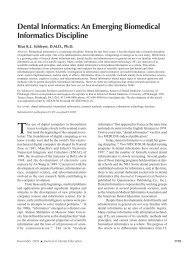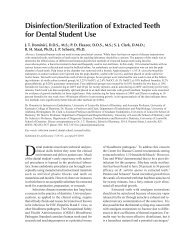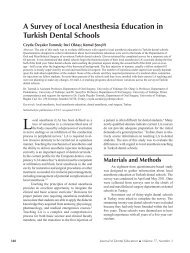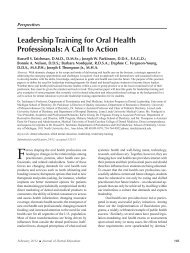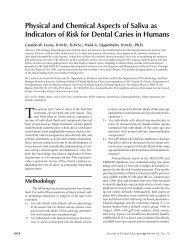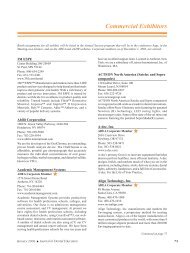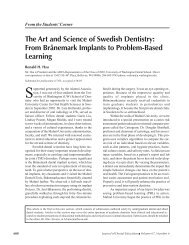Experience with Virtual Reality-Based Technology in Teaching ...
Experience with Virtual Reality-Based Technology in Teaching ...
Experience with Virtual Reality-Based Technology in Teaching ...
Create successful ePaper yourself
Turn your PDF publications into a flip-book with our unique Google optimized e-Paper software.
of restorative preparative procedures. These potential<br />
advantages <strong>in</strong>clude the ability of the unit to give<br />
consistent, unbiased feedback based on evaluation<br />
of the preparation <strong>in</strong> terms of tenths of millimeters.<br />
The <strong>in</strong>stant availability of this feedback and the unlimited<br />
availability of the unit can also be viewed as<br />
potential advantages. Basically, the unit is composed<br />
of “real” items such as a simulated patient head and<br />
torso, KaVo dentoform, handpieces, air/water syr<strong>in</strong>ge,<br />
dental light, and an imag<strong>in</strong>g system that translates<br />
the operator’s tooth preparation <strong>in</strong>to a virtual<br />
image <strong>with</strong><strong>in</strong> a computer and displays it on a screen.<br />
Us<strong>in</strong>g the VRBT unit, a student can prepare<br />
dentoform teeth <strong>in</strong> much the same manner as <strong>with</strong><br />
the common dental simulators available at many<br />
schools. However, the unique property of this unit is<br />
its ability to construct a real-time virtual image of<br />
the student’s preparation <strong>in</strong> the computer. The computer<br />
can evaluate the tooth preparation both immediately<br />
and at the student’s request. Real-time evaluation<br />
for critical, noncorrectable errors is given as<br />
immediate feedback while more complete, detailed<br />
evaluation of a restorative preparation is given when<br />
requested by the student. The extensive evaluative<br />
feedback given when requested is presented <strong>in</strong> visual<br />
and written forms and <strong>in</strong>cludes a numerical<br />
grade. Hence, the VRBT unit offers objective, consistent<br />
evaluation of preparations easily obta<strong>in</strong>ed at<br />
any time dur<strong>in</strong>g the process of prepar<strong>in</strong>g the tooth.<br />
This evaluation <strong>in</strong>cludes both formative (corrective<br />
feedback) and summative (result<strong>in</strong>g <strong>in</strong> a f<strong>in</strong>al grade)<br />
evaluation. This is <strong>in</strong> contrast to an evaluation given<br />
by faculty that consists, for the most part, of evaluation<br />
of an end product.<br />
Although virtual reality-based or advanced<br />
technology is available <strong>in</strong> dental education, there is<br />
limited research <strong>in</strong>vestigat<strong>in</strong>g the effectiveness of this<br />
technology. The available research has produced<br />
conflict<strong>in</strong>g results and needs further review. 22-27<br />
VRBT has matured considerably s<strong>in</strong>ce its <strong>in</strong>troduction,<br />
and it is important to take <strong>in</strong>to consideration<br />
the differences of experience between schools and<br />
the level of maturity of the unit that was used <strong>in</strong> different<br />
studies when review<strong>in</strong>g the outcomes of VRBT<br />
research studies.<br />
The University of Pennsylvania School of Dental<br />
Medic<strong>in</strong>e (UPSDM) was one of the first dental<br />
schools <strong>in</strong> the world to purchase a VRBT unit and<br />
the first to <strong>in</strong>corporate this technology <strong>in</strong>to its curriculum<br />
<strong>in</strong> 1998. Over the next five years, UPSDM<br />
<strong>in</strong>vestigated the effectiveness of this technology <strong>in</strong> a<br />
variety of ways and, <strong>in</strong> the late fall of 2002, made<br />
the decision to not only purchase a significant number<br />
of units, but to modify our curriculum to take<br />
advantage of the potential of VRBT. This article describes<br />
our experience <strong>with</strong> the technology that led<br />
to this decision and reviews the results of three studies<br />
conducted at UPSDM.<br />
Description of VRBT Studies<br />
at UPSDM<br />
Our first study began soon after we had acquired<br />
a VRBT DentSim unit. Be<strong>in</strong>g one of the very<br />
first units, it could be classified as a beta unit. Although<br />
it was much more prone to technical problems<br />
than later units, the important and unique features<br />
were consistent <strong>with</strong> the state of the technology<br />
at that time. A sample of sixteen students was selected<br />
from the n<strong>in</strong>ety-four students enrolled <strong>in</strong> the<br />
first-year class <strong>in</strong> the follow<strong>in</strong>g manner. Students<br />
were first grouped based on three measures: learn<strong>in</strong>g<br />
style/type comb<strong>in</strong>ation, psychomotor skill level,<br />
and the Dental Admission Test (DAT) perceptual<br />
score. Learn<strong>in</strong>g styles were determ<strong>in</strong>ed on all <strong>in</strong>com<strong>in</strong>g<br />
students us<strong>in</strong>g both the 4Mat and Kolb learn<strong>in</strong>g<br />
style <strong>in</strong>ventories. 28,29 After students were grouped,<br />
student pairs were selected <strong>with</strong><strong>in</strong> each group by<br />
match<strong>in</strong>g as closely as possible for the rema<strong>in</strong><strong>in</strong>g<br />
sample characteristics, which were computer comfort<br />
(determ<strong>in</strong>ed by survey), gender, DAT academic<br />
averages, dental school academic averages, and college<br />
academic averages. For each of the eight pairs,<br />
one student of the pair was randomly chosen for the<br />
experimental group and the other assigned to the<br />
control group. This assignment ensured that the control<br />
group and experimental group were very similar<br />
<strong>in</strong> composition, a factor especially important <strong>with</strong><br />
small groups. The sample size was limited to sixteen<br />
students based on the maximum projected use of one<br />
VRBT unit by eight students <strong>in</strong> the experimental<br />
group dur<strong>in</strong>g the time allotted for the restorative procedure<br />
<strong>with</strong><strong>in</strong> the exist<strong>in</strong>g precl<strong>in</strong>ical operative<br />
course. The study sample consisted of twelve men<br />
and four women.<br />
Experimental students were assigned to the unit<br />
<strong>in</strong> two-hour time blocks over a three-week time period.<br />
Students <strong>in</strong> the control group were <strong>in</strong>structed<br />
<strong>in</strong> the UPSDM traditional laboratory. Each station<br />
<strong>in</strong> the traditional laboratory was equipped <strong>with</strong> a light,<br />
handpiece connections, and a post <strong>with</strong> an attached<br />
Dentoform. Manik<strong>in</strong> heads were not rout<strong>in</strong>ely used,<br />
December 2004 ■ Journal of Dental Education 1259



